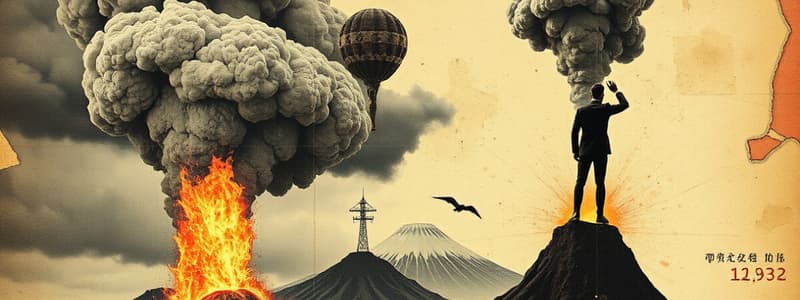Podcast
Questions and Answers
What was the primary cause of the devastation during the Mount Unzen eruption in 1792?
What was the primary cause of the devastation during the Mount Unzen eruption in 1792?
- A lava flow
- A landslide triggered by an earthquake (correct)
- A volcanic ash cloud
- A volcanic gas explosion
The eruption of Nevado del Ruiz in 1985 caused the death of fewer than 15,000 people.
The eruption of Nevado del Ruiz in 1985 caused the death of fewer than 15,000 people.
False (B)
How many people were killed during the eruption of Mount Pelée in 1902?
How many people were killed during the eruption of Mount Pelée in 1902?
30,000
Match the following volcanic eruptions with their outcomes:
Match the following volcanic eruptions with their outcomes:
What was the loudest sound ever heard on Earth attributed to?
What was the loudest sound ever heard on Earth attributed to?
The dust thrown into the atmosphere by the Krakatau eruption helped to block out the sun.
The dust thrown into the atmosphere by the Krakatau eruption helped to block out the sun.
Approximately how many people died as a result of the Krakatau eruption?
Approximately how many people died as a result of the Krakatau eruption?
Match the following events with their effects:
Match the following events with their effects:
Flashcards are hidden until you start studying
Study Notes
Enormous Eruptions
- Volcanoes can be both fascinating and dangerous, with rare eruptions causing widespread devastation.
- The five deadliest recorded volcanic eruptions resulted in significant loss of life.
Unzen (Japan, 1792)
- Mount Unzen erupted, leading to an earthquake and landslide that impacted Shimabara city.
- The landslide initiated a tsunami in the Ariake Sea, resulting in approximately 15,000 deaths.
Nevado del Ruiz (Colombia, 1985)
- The eruption destroyed Armero and caused mudslides affecting the town of Chinchiná.
- Over 25,000 people perished due to the ash and mudflows.
Mount Pelée (Martinique, 1902)
- No warning systems existed during the eruption; the town of St. Pierre was buried in minutes.
- Approximately 30,000 residents died, in part because many fled from rural areas to the town seeking safety.
Krakatau (Indonesia, 1883)
- One of the most significant eruptions in history, creating ash that fell 500 miles away.
- Explosions were reportedly the loudest sounds ever recorded on Earth; they triggered tsunamis killing over 35,000 people.
- The eruption caused atmospheric changes, resulting in vivid red sunsets observed globally.
Tambora (Indonesia, 1815)
- This eruption was the largest ever recorded, blocking sunlight for months, leading to the "year without a summer."
- Areas as distant as Europe and North America witnessed summer snow; crops failed, resulting in widespread disease and famine.
- Nearly 80,000 deaths were attributed to starvation and illness following the eruption.
Additional Facts
- The historical eruptions listed highlight the potential catastrophic consequences of volcanic activity.
- Ongoing eruptions at Krakatau pose no immediate danger despite its active vent.
Studying That Suits You
Use AI to generate personalized quizzes and flashcards to suit your learning preferences.




